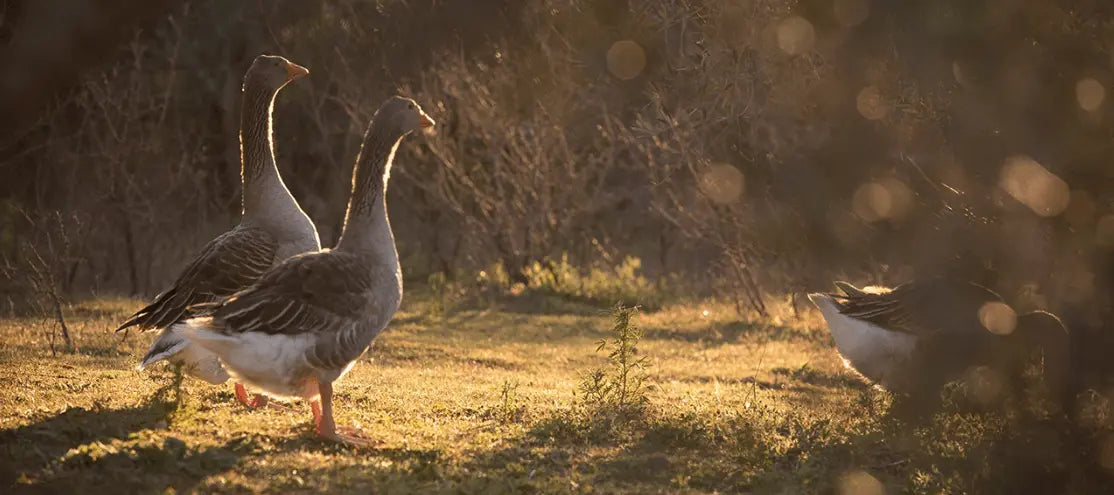
The Story Of Ethical Foie Gras
100% Natural Goose Foie Gras - 'Mi-Cuit'
The Labourdette 'Foie Naturellement Gras' is a seasonal product, that can only be obtained during winter time. This product is smaller than the one obtained with gavage (forced feeding). Labourdette Foie Gras surprises with its taste profile, it has a unique flavour that reminds us of its natural origins.
When you taste it you can appreciate field nuances and a profile less buttery than other types. The main difference from the “gavage” Foie Gras is the higher protein contents and lower fat. Because the geese are taken care of in a sustainable and natural way.
Labourdette respect the seasonal cycle of natural fattening of the goose. And they have adapted to it so the product is obtained under ethical behaviours and going back to the origins and authenticity.
Fat accumulation in the liver cells happens naturally, slow and progressively, in multiple small granules (steatosis micro-vesicular), which adds quality to the Foie Gras. On the other hand the “gavage” Foie Gras (forced fed), all the fat is accumulated in bigger granules (steatosis macro-vesicular) weakening and even breaking the cellular wall.
Thanks to a more natural spread of fat in the “gavage free” liver, it is reduced the “fond” or melting process of the fat when cooking, and the liver keeps its flavour and texture.
Authentic FlavourThat acorn is key to facilitate the natural fat infiltration in the animal meat as well as its liver.
OriginOriginally all Foie Gras came from Goose. But this is not an “easy” animal, as it still keeps part of its wild instinct and its “active” character, and does not tolerate well the confinement in jails, nor forced feeding!
When Foie Gras production became industrialised, geese were not a good option. That is why the French INRA created in 1960 thru genetical crossing of different species, a high-performance hybrid duck named “moulard” designed for industrial massive production:
- More profitable than goose
- Accepts better-forced feeding
- It is mute, so when jailed is not noisy
- Cannot reproduce on its own
- Accumulates fat rapidly, but horrible meat due to lack of exercise
Now, only 10% of Foie Gras is made from Geese (and most of it force-fed with gavage).
The other 90% comes from massive factory-farms of “moulard” ducks.
Goose foie gras, with slightly pink colour, is a rare product of higher quality: silky texture and soft taste. Duck foie gras is more yellowish, with a more rude flavour & taste due to its massive production
Many of the flavours and aromas in Labourdette products come from the acorn (bellota). It brings a very special texture in mouth.
Acorn (bellota) is the fruit of the holm oaks, centenary trees that make the “dehesas” (meadows) where the geese grow in total freedom. This fruit is only available from October to January, and when is ripe it falls on the ground. This is the “montanera” natural fattening period of our geese. They eat lots of acorn while walking and flying plenty of kilometres to get that acorn fruit. These are the same acorn-rich in oleic acid that feeds the Iberian pig and generates its fat infiltration.
Acorn is a highly caloric food that generates natural fat infiltration in the meat and liver of our geese. Many of the flavours and aromas we get in our products come from the acorn (bellota). It brings a very special texture in the mouth.
The goose meat is different because of its shiny red colour and its fine marbling (intra-muscle fat infiltration). It is a meat that resembles the hunting one, able to evoke the link to the earth, the passion and careful love on its preparation.
The Labourdette project demonstrates that it is possible to make Foie Gras without crossing any ethical limits.
'Gavage'Foie Gras available in the marketplace is made with the “gavage” system: animal cruelty consisting of force-feeding (with funnels or pneumatic machine) over three weeks the animals are confined to cages within industrial sheds, with the objective of forcing the growth of their liver.
On the contrary, Labourdette geese are not force-fed, and so it demonstrates that it is possible to make Foie Gras without animal cruelty and without unjustified techniques!
Labourdette respect and understand the natural fattening seasonal cycle, and how to adapt to it. Instead of fighting against nature and trying to force it, they have become its ally. Instead of imposing rules on the animals, they follow mother nature to obtain products in a more harmonious way.
Product quality is linked to the production methodology. A slow and careful production, with varieties adapted to the land where they grow, do translate into exceptional seasonal products.

